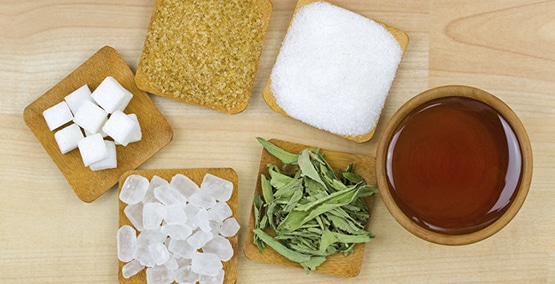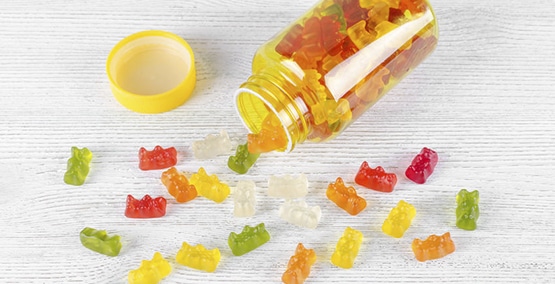
Sugar and sugar substitutes

Most children (and adults) love sweets. Not just candies, but sweet desserts, sweet cereals and sweet drinks. But the problem is that sugar adds a lots of calories to what children eat and drink. Regular sodas have as many as 10 teaspoons of sugar in a single 12 ounce can. Fruit juices, like apple juice, have the same amount of sugar as sugary sodas. Grape juice has even more. It's no wonder dentists and doctors warn parents that juice in bottles is unhealthy.
Many parents are looking for alternative sweeteners for their children and themselves. There are lots of different sugar alternatives.
In the table below, sweeteners are divided into 2 categories. Nutritive sweeteners are those, like sugar and honey, that the body can use for energy and the body's metabolic needs. The non-nutritive sweeteners provide the sweet taste, but they can't be used by the body in the same way.
The concern for the nutritive sweeteners is that too much can contribute to the problems of weight gain and obesity. And the real concern is that diet drinks (with various sweeteners) still doesn't make them into healthy choices. Especially when compared to the original diet drink – water.
SWEETENERS
| Nutritive | Common Names | Characteristics | De rived From | Found in | Concerns/issues |
|---|---|---|---|---|---|
| Nutritive | |||||
| Sucrose | Table Sugar | 50% glucose + 50% fructose 4 kcals/gm;40 kcals/Tbsp | sugar cane or sugar beet | honey, fruits, most root vegetables | Tooth Decay; Increased intake leads to obesity, high blood sugars, Type 2 Diabetes, Gout |
| Fructose | Fruit Sugar | lowest GI of all sugars sweetest of all sugars 4 kcals/gm; 40 kcals/Tbsp | sugar cane, sugar beet or corn | table sugar, High Fructose Corn Syrup (HFCS), agave, honey, molasses, maple syrup, fruit, root vegetables | Increased intake leads to obesity, insulin resistance + hyperlipidemia; May not regulate satiety, leading to overeating; may contribute to liver disease, Gout |
| HFCS | High Fructose Corn syrup | 50% glucose + 50% fructose as "free sugars"; in sucrose these are "bound" but when digested it quickly turns into "free sugars" as well 4 kcals/gm;40 kcals/Tbsp | produced by changing corn into corn starch into corn syrup and then adding enzymes | processed foods | Increased intake leads to obesity, insulin resistance + hyperlipidemia |
| Honey | honey | mixture of sugars including glucose + fructose; 1-1.5x sweeter than sugar; 3 kcals/gm; ~64 kcals/Tbsp | produced by honey bees from the nectar of plants or secretions of living parts of plants | Increased intake leads to obesity, insulin resistance + hyperlipidemia; risk of infant botulism so avoid in babies <1 yo | |
| Agave | agave nectar | nutritionally and functionally similar to other sugars, including HFCS depending on how it is processes1.5x sweeter than sugar; ~60 kcals/Tbsp | Blue Agave plant which is same plant from which tequila comes from | in a syrup or in processed foods | Increased intake leads to obesity, insulin resistance + hyperlipidemia; processed just like other sugars |
| Non-nutritive | |||||
| Sucralose | Splenda | 600x sweeter than sugar; poorly absorbed by body and excreted unchanged in urine; heat stable | process that replaces 3 hydrogen-oxygen groups on sucrose with chlorine atoms | tabletop sweetener and as an ingredient in variety of processed goods | 100+ scientific studies over 20 yrs looking at variety of health issues demonstrated safety |
| Aspartame | Equal, NutraSweet | 180x sweeter than sugar; not heat stable | molecule consisting of phenylalanine + aspartic acid | tabletop sweetener and as an ingredient in variety of processed goods | vast majority of research over 30+ yrs concludes that it does not cause cancer. 2 studies that say otherwise were done in rats and were poorly designed studies; contains phenylalanine- must be avoided by people with PKU |
| Saccharin | Sweet'N Low | 300x sweeter than sugar; heat stable; not broken down by body and eliminated in same form | chemical process | tabletop sweetener and as an ingredient in variety of processed goods | studies in 70's in rats linked it to bladder cancer. However, the bladder tumors were due to how the substance worked in rats and is not relevant to humans. 12/2000- warning label no longer required |
| Stevia | Truvia, PureVia, Sun Crystals | 200x sweeter than sugar | stevia plant | tabletop sweetener and as an ingredient in variety of processed goods | multiple studies have shown they are not associated with cancer |
| Monk Fruit | Purefruit, Nectresse | 200x sweeter than sugar | fruit grows on vines in sub-tropical Asia; processors extract the natural sweetener by crushing it and infusing with hot water | tabletop sweetener and as an ingredient in variety of processed goods | multiple studies have shown they are safe for human consumption |




